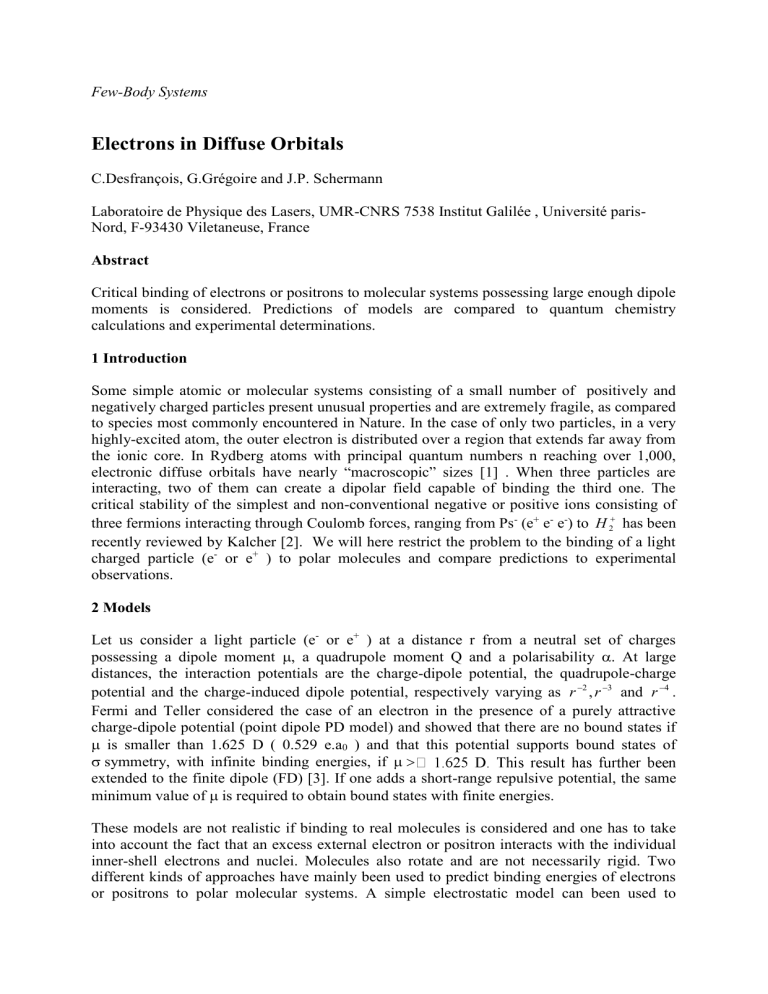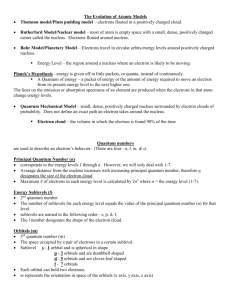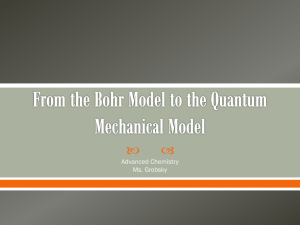Few-Body Systems

Few-Body Systems
Electrons in Diffuse Orbitals
C.Desfrançois, G.Grégoire and J.P. Schermann
Laboratoire de Physique des Lasers, UMR-CNRS 7538 Institut Galilée , Université paris-
Nord, F-93430 Viletaneuse, France
Abstract
Critical binding of electrons or positrons to molecular systems possessing large enough dipole moments is considered. Predictions of models are compared to quantum chemistry calculations and experimental determinations.
1 Introduction
Some simple atomic or molecular systems consisting of a small number of positively and negatively charged particles present unusual properties and are extremely fragile, as compared to species most commonly encountered in Nature. In the case of only two particles, in a very highly-excited atom, the outer electron is distributed over a region that extends far away from the ionic core. In Rydberg atoms with principal quantum numbers n reaching over 1,000, electronic diffuse orbitals have nearly “macroscopic” sizes [1] . When three particles are interacting, two of them can create a dipolar field capable of binding the third one. The critical stability of the simplest and non-conventional negative or positive ions consisting of three fermions interacting through Coulomb forces, ranging from Ps (e + e e ) to H
2
has been recently reviewed by Kalcher [2]. We will here restrict the problem to the binding of a light charged particle (e
-
or e
+
) to polar molecules and compare predictions to experimental observations.
2 Models
Let us consider a light particle (e or e + ) at a distance r from a neutral set of charges possessing a dipole moment
, a quadrupole moment Q and a polarisability
. At large distances, the interaction potentials are the charge-dipole potential, the quadrupole-charge potential and the charge-induced dipole potential, respectively varying as r
2
, r
3
and r
4
.
Fermi and Teller considered the case of an electron in the presence of a purely attractive charge-dipole potential (point dipole PD model) and showed that there are no bound states if
is smaller than 1.625 D ( 0.529 e.a
0
) and that this potential supports bound states of
symmetry, with infinite binding energies, if
extended to the finite dipole (FD) [3]. If one adds a short-range repulsive potential, the same minimum value of
is required to obtain bound states with finite energies.
These models are not realistic if binding to real molecules is considered and one has to take into account the fact that an excess external electron or positron interacts with the individual inner-shell electrons and nuclei. Molecules also rotate and are not necessarily rigid. Two different kinds of approaches have mainly been used to predict binding energies of electrons or positrons to polar molecular systems. A simple electrostatic model can been used to
interpret experiments involving electrons and polar molecules or weakly-bound complexes
[3]. It considers the above given interactions at large distances and a repulsive interaction described by a single empirical repulsion parameter which slightly depends only upon the molecular polarisability
and exchange effects between the excess electron and the electrons of the neutral molecular core. It nevertheless provides reliable predictions of electron binding energies to polar or quadrupolar molecular systems, even for dipole or quadrupole moment values close to the critical values where quantum calculations usually fail. A similar model would be difficult to apply to positron-molecule binding since annihilation effects would then have to be taken into account.
A much deeper understanding of electron and positron binding to polar molecules can be obtained from quantum chemistry calculations. In those calculations, one must take into account the extremely diffuse character of the weakly bound electron or positron orbitals and also one must have an accurate description of the neutral molecular core through valence orbitals [4]. These valence orbitals must first correctly describe the static charge distribution which provides the electrostatic potential experienced by the excess electron or positron. The excess electron or positron polarizes the neutral molecular core and a large fraction of the binding energy arises from correlation effects. These effects are somewhat similar to dispersion interactions leading to van der Waals interactions and they improve the description of the charge distribution of the neutral molecular core with respect to a simple Hartree-Fock approximation. For electron binding to molecules, correlation effects are well taken into account in standard quantum chemistry calculations. The respective dependences of electron binding energies as function of basis sets supplemented with diffuse orbitals and function of electronic structures methods (from MPn to CCSDT) are discussed in depth in reference [5].
After more than 30 years of theoretical efforts, the situation is now satisfying for the predictions of formation of anions into which electrons are bound to molecules with dipoles exceeding a critical value ca. 2.5 D.
The situation is quite different for positron binding to polar molecules. Usual methods of quantum chemistry encounter great difficulties to correctly include electron-positron interactions. Density functional theory (DFT) [6], quantum Monte-Carlo [7], Hartree-Fock [8] and, very recently, configuration interaction ab initio calculations [9] have been applied to the problem of molecular anion formation from positron attachment. In table I, predicted positron
(PA) and electron affinities (EA) of urea and acetone, as well as experimental values of the corresponding EA are compared. Acetone is interesting because its dipole moment is close to the experimental critical value (see below) and it represents a benchmark for calculations.
There is a remarkable similarity between the EA and the PA values which may be due to the extreme diffuseness of the excess electron and positron orbitals: the difference between electron/molecule and positron/molecule short-range interactions hardly intervene. For urea, the predicted values can only be compared for the anti configuration which is the lowestenergy configuration of this molecule. However, large amplitude motions can take place in this molecule and the dipole moment can vary over a wide range. This effect which has been ignored into account either in the early PD or the FD models must be taken into account in comparison between predictions and measurements.
3 Experimental methods
There exist different experimental signatures of the existence of electrons bound to molecular systems in diffuse molecular orbitals. When an electron which is bound by long-range
potentials is submitted to an external electric field, it remains bound at short distances but can be pulled out at large distances. This has been demonstrated for optical electrons of Rydberg atoms [1] ( Coulomb potential) and excess electrons of dipole- and quadrupole-bound anions
[10]. In contrast, even extremely weakly bound excess electrons of conventional anions cannot be detached by external electric fields. If one considers the two-body problem of attachment of a free electron to an isolated molecule, the obtained molecular anion is unstable with respect to the reverse process, i.e. autodetachment of the excess electron. The presence of a third-body stabilizing the so-called nascent anion is necessary. In order to set an excess electron into a diffuse orbital, a systematic procedure consists in preparing this electron in an already diffuse orbital. This is accomplished in charge-exchange collisions between highlyexcited (Rydberg) atoms A
**
(n) and polar molecular systems M. The charge-exchange process takes place when the classical frequency with principal quantum number n is equal to
Hartree / n
3 of the electron in the atom
EA / that in the molecular anion M with binding energy EA. The signature of the creation of an anion with an excess electron in a diffuse orbital is then a peaked dependence of the anion creation rate as a function of the quantum number n of the Rydberg atom [11]. This simple idea leads to the following relationship between the n-value n max
at which the anion creation rate is maximum and the electron binding energy: EA
27 , 2 eV / n
3 max
. A detailed interpretation, with a multiple curvecrossing model, of the experimental data of charge-exchange collisions between excited atoms and polar molecular systems [12] provides the electron binding energies which are related to the measured n max
values by the following empirical relationship:
EA
23 eV /
2 .
8 n max
. The anions produced under single-collision conditions are stabilized against autodetachment by the presence of the positive atomic core A
+
which acts as a thirdbody. Dipole-bound anions thus have, in principle, an infinite lifetime unless an external perturbation is applied, for example an external electric field or collisions with a background gas or black-body radiation [13] . A third diagnosis is provided by the reverse process of electron binding, photodetachment of the weakly-bound anion M
-
. When an anion in its vibrational ground state and electron binding energy EA is submitted to a radiation of energy h
larger than its vertical detachment energy, electrons are detached with a kinetic energy eKe and a neutral core M is left. The dependence of the photoelectron yield as a function of eKe is broad in the case of conventional anions but it exhibits narrow peaks for anions with excess electrons in diffuse orbitals [14,15].
While the situation becomes now relatively satisfactory when comparisons are conducted between theoretical predictions and experimental observations of electron attachment processes to molecular polar systems, the observation of positron binding to polar systems remains challenging. Theoretical calculations predict that molecules with dipole moments exceeding a critical value in between 3-4 D [8] and even down to 2.88 D ( acetone) [9] should lead to the creation of dipole-bound anions. Experimentally, positron-molecule collisions are now performed at very low energies with cold positron beams tuneable down to 50 meV [16]
(with an energy resolution of 25 meV). Due to annihilation, it is difficult to envision the existence of long-lived ions produced in collisions between positrons and molecules but in view of the predictions of quantum chemistry calculations described above, one might expect to observe a large influence of the dipole moment on positron-polar molecule scattering processes. The experimental observable is then the annihilation rate of the low-energy positrons. By convention, this rate is expressed in terms of the dimensionless effective number of electrons Z eff
of the molecular target. Z eff
takes into account the fact that this target contains several electrons and that the incoming positron motion is influenced by the attractive dipole and polarisability long-range potentials. The positron annihilation cross
sections
a
are then written as
a
r
0
2 c v
Z eff
where r
0
is the classical radius of the electron.
If the Born approximation was applicable, Z eff
would simply be equal to the total number Z of electrons in the molecular target. In practive, unexpected large annihilation rates corresponding to Z eff
values larger than 10
5
are experimentally observed [16] and interpreted as due the existence of positron capture in vibrational Feshbach resonances [17]. As shown in
Table II, there no clear evidence of any correlation between measured values of Z eff
and dipole moments. Those dipole moments are below the predicted critical values but resonant electron-molecule scattering processes are strongly dependent upon dipole moments, even for dipoles below the critical value [18]. The same situation does not seem to take place for positrons and it may thus not be totally certain that measurements of annihilation rates can lead to observation of positrons temporary bound to molecules in very diffuse orbitals, as predicted from quantum chemistry.
4 Other fragile molecular systems with electrons in diffuse orbitals
It has been recently predicted that an atomic positive core A + and an electron e orbiting in an extremely diffuse orbital can bind another atom A. In such a so-called trilobite molecule, the atomic cores could be separated up to 5 microns [19] and the molecular dipole moment of this homonuclear A
2
molecule could be roughly 1,000 times larger than that of typical diatomic polar molecules.
Some molecules possess two polar ends, each capable of electron binding. Their ability to bind two electrons, leading to bi-dipole bound anions, have been investigated theoretically
[20]. Their critical stability is related to the spacing between the dipoles which must be large enough to overcome the repulsion between the two excess electrons.
5 Conclusion
Electron and positron binding to polar molecules can be studied by means of simple theoretical models [21], quantum chemistry and in several cases experimentally. It constitutes tests of critical binding with realistic potentials. The existence of very diffuse orbitals leads to the observation of unusual properties and also to new mass-spectrometric methods well-suited for the study of very fragile molecular systems [22].
Table I. Comparison between quantum chemistry calculations, electrostatic model predictions and available experimental determinations of electron affinities (EA) and positron affinities
(PA) molecule
Urea anti
Urea syn
Acetone dipole
3.57 D
4.26 D
2.88 D
EA ab initio
15 meV
40 meV
EA model
16
4 meV
40
meV
2.8 meV
EA experimental
PA ab initio
13.4 meV
35 meV
3.2 meV 4.3 meV
Table II Effective number of electrons of molecules Z eff
(see text) determined in positron annihilation experiments [16] molecule dipole moment
CCl
4
0
NO
2
0.32 D
NH
3
1.47 D
H
2
O
1.85 D
Z eff
9530 1090 1600 319
Figure 1 Electron (EA) and positron (PA) binding energies as a function of molecular dipole moments. The variational Monte-Carlo (MC) [7] and ab initio [9] PA predictions are compared to EA experimental determinations [11] and predictions of a pseudopotential model
[12]. The arrow indicates the critical moment value of the PD and FD models [3].
10 2
10 1
10 0
10 -1
10 -2
ab initio PA calculation variational MC PA calculation pseudopotential EA calculation experimental EA
2 3 4 5 molecular dipole moment (D)
6
References
1
F. B. Dunning, J.Phys.B 28 , 1645 (1995).
2
J. Kalcher, in Theoretical prospect of negative ions , edited by J. Kalcher (Research
Signpost, 2002).
3
H.Abdoul-Carime, J.P. Schermann, C.Desfrançois, Few-Body Systems. 31 , 183
(2002).
4
P. Skurski, M. Gutowski, and J. Simons, Int.J.Quantum.Chem. 80 , 1024 (2000).
5
M. Gutowski, K. D. Jordan, and P. Skurski, J.Phys.Chem. 102 , 2624 (1998).
6
D. G. Kanhere, A. Kshirsagar, and V. Bhamre, Chem.Phys.Lett. 160 , 526 (1989).
7
9
D. Bressanini, M. Mella, and G. Morosi, J.Chem.Phys. 109 , 1716 (1998).
8
(2002).
M. Tachikawa, I. Shimamura, R. J. Buenker, et al ., Nucl.Inst.Methods B 192 , 40
M. Tachikawa, R. J. Buenker, and M. Kimura, J.Chem.Phys. 119 , 5005 (2003).
10
H. Abdoul-Carime and C. Desfrançois, Eur.Phys.J..D 2 , 149 (1998).
11 C. Desfrançois, H. Abdoul-Carime, N. Khelifa, et al ., Phys.Rev.Lett. 73 , 2436 (1994).
12 C. Desfrançois, Phys.Rev.A
51 , 3667 (1995).
13
L. Suess, Y. Liu, R. Parthasarathy, et al ., Chem.Phys.Lett. 376 , 376 (2003).
14
J. H. Hendricks, S. A. Lyapustina, H. L. d. Clercq, et al ., J.Chem.Phys. 108 , 8 (1998).
15
S. Y. Han, J. K. Song, J. H. Kim, et al ., J.Chem.Phys. 111 , 4041 (1999).
16
S. J. Gilbert, L. D. Barnes, J. P. Sullivan, et al ., Phys.Rev.Lett. 88 , 043201 (2002).
17
G. Gribakin, Nucl.Inst. and Methods B 192 , 26 (2002).
18
M. Allan, J.Phys.B At.Mol.Opt.Phys. 36 , 2489 (2003).
19
E. L. Hamilton, C. H. Greene, and H. R. Sadeghpour, J.Phys.B. 35 , L199 (2002).
20
M. Gutowski, P.Skurski, and J. Simons, Int.J.Mass Spectr. 201 , 245 (2000).
21
G. P. Sastry, V. Srinivas, and A. V. Madhav, Eur.J.Phys. 17 , 275 (1996).
22 C. Desfrançois, S. Carles, and J. P. Schermann, Chem.Rev. , 3943 (2000).







